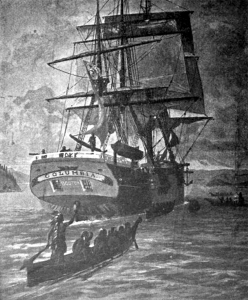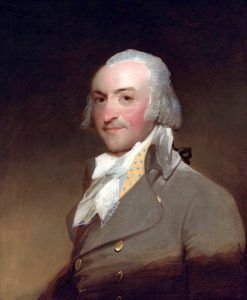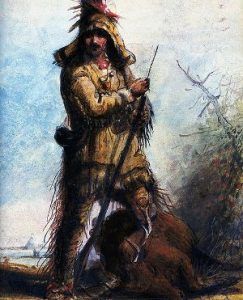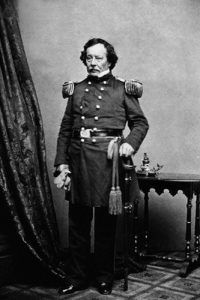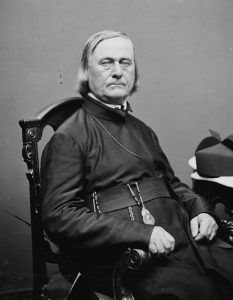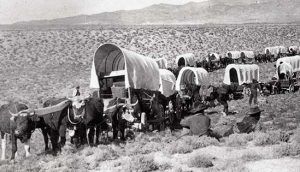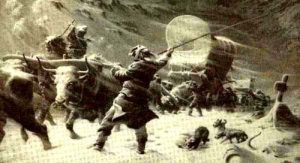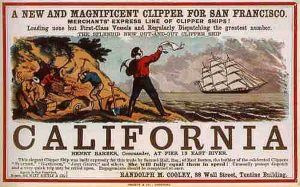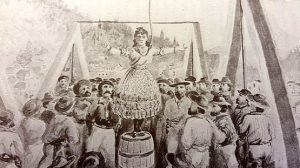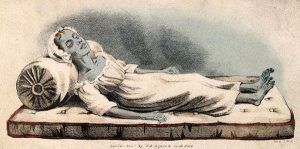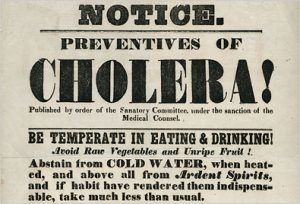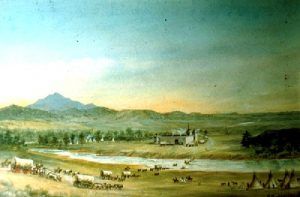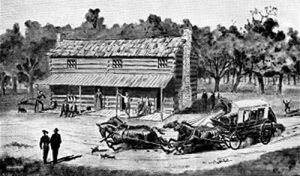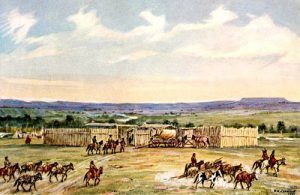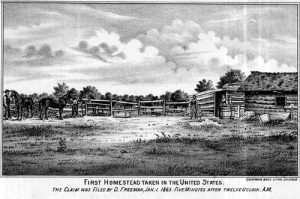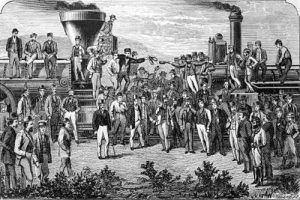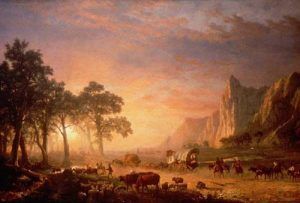For 25 years, as many as 500,000 people traveled the overland trails to Oregon, California, and Utah. It is estimated that Oregon was the destination for about a third of the emigrants, California for another third, and the remainder were bound for Utah, Colorado, and Montana.
1700s
British fur agents arrive along the Columbia River in the Oregon Country to establish trading posts.
1792
American sea captain Robert Gray explored the mouth of the Columbia River on his ship, the Columbia, and claims the region for the United States.
1793
Explorer Alexander Mackenzie completed an expedition that was the first to come overland to the Pacific through the Rocky Mountains.
1803
The United States, under President Thomas Jefferson, purchased the Louisiana Territory.
1805-06
The Lewis and Clark Expedition reaches Oregon.
1811
John Jacob Astor establishes an American trading post in the Oregon Country.
1812-1813
John Jacob Astor’s partner in the American Fur Company, Duncan McDougall, dispatches a party led by Robert Stuart, overland and eastbound. The group blazes the route that would later become known as the Oregon Trail. Though they find a break in the Rocky Mountains called South Pass, the discovery is forgotten for a decade.
1818
The Treaty of 1818 established the border between the United States and Great Britain’s Canada at the 49th parallel up to the Rocky Mountains. The treaty allows for the joint control of the Oregon Territory
1820
The western fur trade begins.
1823-1824
Fur trade organizer William Ashley of the Rocky Mountain Fur Company and mountain man Jedediah Smith take a party of trappers along the trail from east to west, rediscovering South Pass.
1825-1826
William Ashley and Jedediah Smith, in search of new trapping grounds, lead the first wagon parties along the trail through South Pass, Wyoming, and eventually make their way to California.
1827
Dr. John McLoughlin, director of the Hudson’s Bay Company, builds the first lumber mill in the Pacific Northwest at Fort Vancouver, Washington.
1828
Rejoining his expedition in California, Jedediah Smith leads the way north into Oregon, where only Smith and three others escape an Indian massacre on the Umpqua River. The survivors flee to the Hudson’s Bay Company outpost at Fort Vancouver, Washington.
1829
Easterner Hall Jackson Kelley organizes a missionary society to take the Gospel to the western Indians. His plans don’t come to fruition, but he eventually makes it to Oregon.
1830
Jedediah Smith and William Sublette, partners in the Rocky Mountain Fur Company, lead the first wagon train (10 wagons) across the Rocky Mountains at South Pass and on to the Upper Wind River. The six-week journey proved that even heavily loaded wagons and livestock could travel overland to the Pacific.
1832
U.S. Army Captain Benjamin Bonneville succeeds in taking wagons along the Oregon Trail as far west as Wyoming’s Green River.
Nathaniel Wyeth successfully leads a wagon party of colonizers to the Willamette River in present-day Oregon.
1834
William Sublette and Robert Campbell establish Fort Laramie on the North Platte River in Wyoming, the first permanent trading post in the region and an important stopping point for pioneers traveling the Oregon Trail.
Methodist minister Jason Lee and a party of missionaries take the Oregon Trail to Oregon.
1836
Responding to the 1831 Nez Perce request for teachers, the Whitman party, including Dr. Marcus Whitman and his wife, Narcissa, the Reverend H. H. Spalding, and his wife, Eliza, travel what will soon be known as the Oregon Trail. They arrived at the junction of the Columbia and Snake Rivers, where they established a mission to bring Christianity to the Indians of the northwest. Narcissa and Eliza were the first white women to cross the Rocky Mountains.
1839
Organizer Thomas Jefferson Farnham organizes the emigrant party called the Oregon Dragoons. Due to many hardships, many of the emigrants turn back, but Farnham reaches Oregon.
1840
Catholic Jesuit priest Father Pierre Jean De Smet takes the Oregon Trail west and establishes a mission in Oregon.
1841
The first emigrant party, the Bidwell-Bartleson party, heads for California with 100 farmers and their families. After crossing South Pass, the group divides, some going to California and some to Oregon.
1842
Dr. Elijah White, the newly appointed Indian Sub-Agent to Oregon, led 112 emigrants to Oregon. Their wagons were cut down to two-wheeled carts at Fort Hall, Idaho, as it was generally believed at that time that wagons could not make the journey over the upcoming rough terrain.
Lieutenant John C. Fremont of the Army Topographical Corps leads a scientific expedition into the Rocky Mountains, guided by mountain man Kit Carson. On his return, Fremont’s account of the expedition and expert maps are ordered published by Congress. His reports encouraged Americans to go West on the trail.
The U.S. Congress passed the Preemption Bill, which permitted any American to occupy or “squat” on a piece of land before being surveyed by the government. The law encouraged Americans to move to the Oregon Country.
1843
Some 1000 people outfit in the small town of Elm Grove, Missouri. Called “the great migration,” the train comprised more than 100 wagons with a herd of 5,000 oxen and cattle trailing behind. After more than 2000 miles, they arrived at Oregon’s Willamette Valley.
Oregon’s Provisional Government was formed in anticipation of the arrival of the emigrants of the great migration from Missouri.
Seasoned mountain men Jim Bridger and Louis Vasquez established Fort Bridger on the Green River to re-supply migrants traveling the Oregon Trail. Theirs was perhaps the first mountain outpost not designed as a trading post for trappers.
Again guided by Kit Carson, John C. Fremont launched a more ambitious expedition into the West. Fremont’s report, published in 1844, again by Congressional order, became a best-seller, and his map of the West became a travel guide to pioneers on the Oregon Trail.
1844
Four major wagon trains bring 2000 farmers, merchants, mechanics, and lawyers to Oregon.
1845
An estimated 5,000 Oregon-bound emigrants are on the trail this year, most of them departing from Independence and Westport, Missouri.
1846
A relatively light year, with just 1,000 emigrants heading to California and Oregon. Barlow’s Mount Hood Toll Road and Applegate’s Southern Route extend the Oregon Trail into the Willamette Valley.
Britain and the United States reached a compromise in the Pacific Northwest, setting the Oregon Territory’s northern border at the 49th parallel.
The Donner Party, trapped by heavy snows when it attempts to follow the Hastings Cutoff through the Sierra Nevada Mountains into California, is driven to cannibalism as it attempts to survive the winter.
The Applegate Trail was blazed by brothers Lindsay, Jesse, and Charles Applegate as an alternative route to Oregon.
1847
A new destination opens as Brigham Young leads the Mormon Brigade to Utah.
Cayuse warriors massacre Dr. Marcus Whitman, his wife, Narcissa, and twelve others at Waiilatpu, their mission on the Columbia River, in reprisal for deaths caused by a measles epidemic among their tribe.
1848
The massive Mormon exodus swells the ranks of the emigrants to some 4,000 pioneers.
Cholera strikes Independence, Missouri, at which time Council Bluffs, Iowa and St. Joseph, Missouri become the leading jumping-off points.
The United States recognizes Oregon Territory as an official territory.
James Marshall discovers gold on the American River at Coloma, California, while building a lumber mill for John Sutter.
The discovery of gold in California draws off more than three-quarters of the male population of Oregon, but most return before the arrival of the 49ers the following year.
In December, President James K. Polk confirmed the discovery of gold in California, sparking a nationwide stampede to the West.
1849
The Oregon Trail is crowded with Forty-niners heading for California’s goldfields. With more than 30,000 people traveling the trail, they expand the network of trails across the continent as wagon trains stretch across the plains and struggle through the mountains.
Forty-niners pioneer the boomtown life that will follow miners throughout the West, a life of desperately hard work, gambling, drinking, violence, and vigilante justice.
“Pretty Juanita” was convicted of murder after stabbing a man who had tried to rape her. She became the first person hanged in the California mining camps.
By year’s end, more than 80,000 fortune-seekers have made their way to California from every corner of the world, nearly tripling the territory’s population.
A guide was published describing the overland journey to California.
Cholera spreads west along the trail, helped by damp weather.
1850
Some 55,000 emigrants make this the year of the highest migration, but cholera runs rampant, killing thousands.
Five Cayuse Indians are hanged in Oregon City for the Whitman Massacre.
California enters the Union.
Many California’s Indians, finding themselves deprived of their traditional food sources, began to raid mining camps and white settlements.
The California legislature responds to the situation with an Indenture Act, which establishes a form of legal slavery for the native peoples by allowing whites to declare them vagrant and auction off their services for up to four months. The law also permits white settlers to indenture Indian children with the permission of a parent or friend and leads to the widespread kidnapping of Indian children.
The Donation Land Act was passed by Congress, which offered free land to white settlers and “half-breed Indians.”
1851
As word of the cholera epidemic spreads, travel on the trails is reduced to about 10,000.
The United States and representatives of the Lakota, Cheyenne, Arapaho, Crow, Arikara, Assiniboin, Mandan, Gros Ventre, and other tribes signed the Fort Laramie Treaty of 1851, which was intended to ensure peace on the plains.
John L. Soule, in an editorial in the Terre Haute Express, advises: “Go West, young man, go West.” But New York Tribune editor Horace Greeley gets credit for the line.
1852-1853
As the cholera epidemic had nearly burned itself out, the gold rush was back on. Some 70,000 people head west in these years, about 50,000 in 1852 and 20,000 in 1853.
1854
Most of the 10,000 emigrants on the trails this year are headed for Oregon.
Problems arise as an Army command is annihilated near Fort Laramie, Wyoming precipitating a three-year Indian war.
1855-1857
Indian wars in the west keep emigration down to only 5000 each year.
1858
Gold was discovered in Colorado.
Heavy freight traffic to the military forts ensures safety for some 10,000 emigrants traveling this year.
1859
This year, about 30,000 people travel the trails destined for Colorado, Utah, California, and Oregon.
Stagecoaches make their first appearance on the Oregon Trail with the Leavenworth and Pikes Peak Express carrying passengers and mail.
After many years of continued emigration to the Oregon territory, Oregon officially became a State
1860
Fifteen thousand people escape the threat of the Civil War by moving west.
Silver strikes bring thousands to Nevada.
Russell, Majors, and Waddell begin the Pony Express from St. Joseph, Missouri, to Sacramento, California.
1861
Crews working on completing a coast-to-coast telegraph line meet at Fort Bridger in Utah Territory. The first transcontinental telegram, transmitted from Sacramento to Washington, carried a message from the state’s Chief Justice to President Abraham Lincoln. Completion of a transcontinental telegraph line signals the end for the Pony Express.
Ben Holladay extends his stage company to Oregon.
1861
Removing troops from the western frontier to fight in the Civil War dropped emigration to 5000.
The Pony Express goes bankrupt following the completion of transcontinental telegraph lines.
1862
Congress passed the Homestead Act, allowing citizens to settle on up to 160 acres of surveyed but unclaimed public land and receive title after making improvements and residing there for five years.
1863
Word of gold strikes in Montana filter back east, increasing traffic on the Oregon Trail.
1864-1865
Traffic on the trail was the heaviest since the California Gold Rush, as many emigrants were bound for Montana via the Bozeman Trail. Some 20,000 traveled in 1864 and 25,000 in 1865, despite Sioux uprisings at several points along the way.
1866
Trail travel remains at about 25,000 per year, but the end of the overland trails era begins with forming the Union Pacific Railroad Company.
1869
A Golden Spike completes the transcontinental railroad at Promontory Point, Utah.
Following the meeting of the rails, an immigrant could travel from Omaha, Nebraska, to the Pacific Ocean in less than two weeks. However, wagon trains could still be seen on the Oregon Trail through the 1880s. Ezra Meeker drove the last wagon widely known to have braved the Oregon Trail in 1906.
Compiled by Kathy Alexander/Legends of America, updated December 2021.
Also See:
Danger and Hardship on the Oregon Trail
Disease and Death on the Overland Trails
Oregon-Mormon-California-Pony Express Trails Photo Gallery
Oregon Trail – Pathway to the West
Sources:
American Westward Expansion
Historic Oregon City
McNeese, Tim; The Oregon Trail: Pathway to the West, Chelsea House Publishing, 2009.
PBS – The West


